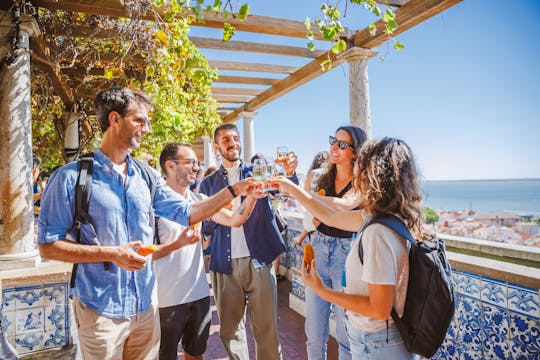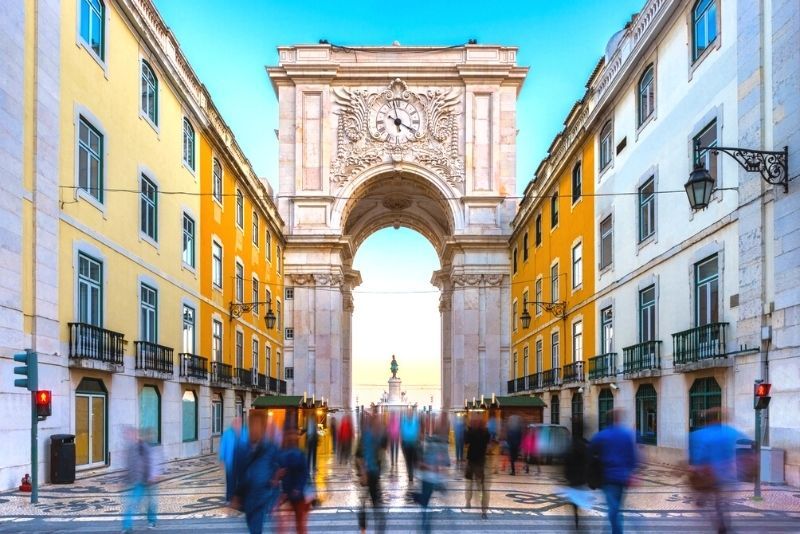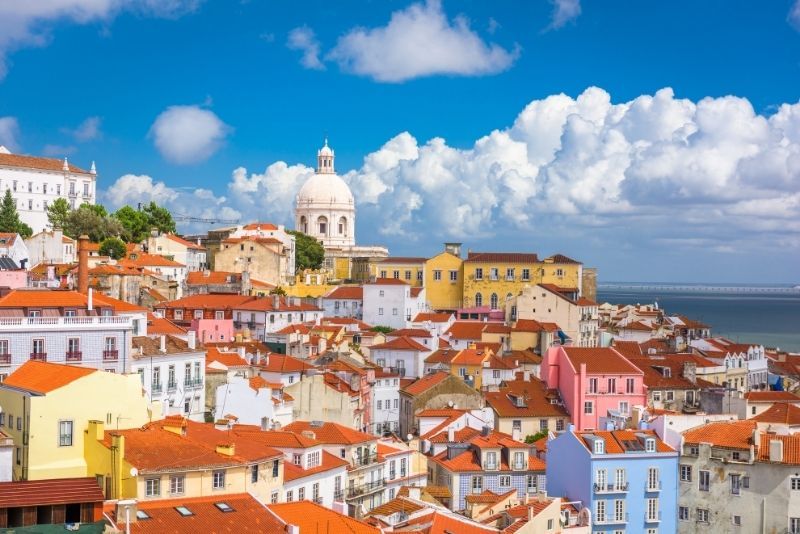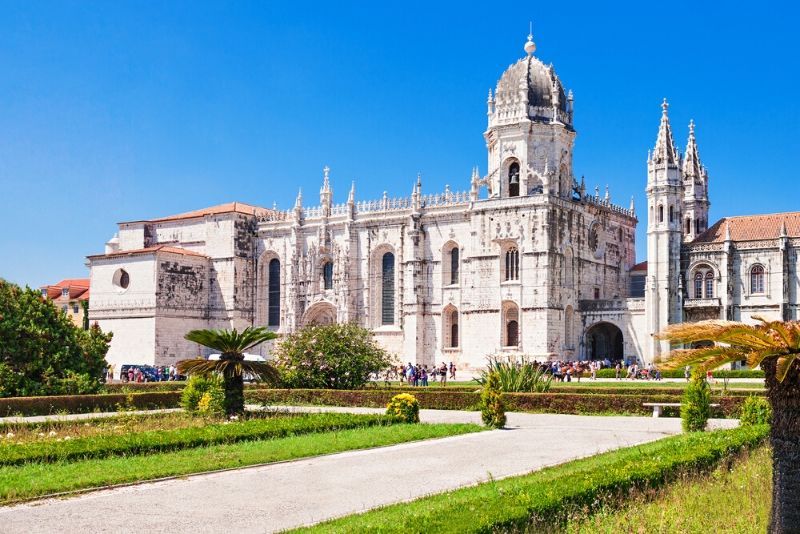Walking Tours in Lisbon
Lisbon is one of Europe’s most popular destinations and it’s easy to see why — intricate architecture, charming cobblestone streets and great food and wine all combine to create the perfect tourist destination.
But Portugal’s capital isn’t just about sunshine, wine and pretty buildings — take a closer look and you’ll find an energy and pulse that’s unique to Lisbon.
Lisbon is one of Europe’s most popular destinations and it’s easy to see why — intricate architecture, charming cobblestone streets and great food and wine all combine to create the perfect tourist destination.
But Portugal’s capital isn’t just about sunshine, wine and pretty buildings — take a closer look and you’ll find an energy and pulse that’s unique to Lisbon.

(0/24) checking Musement...
Lisbon is one of Europe’s most popular destinations and it’s easy to see why — intricate architecture, charming cobblestone streets and great food and wine all combine to create the perfect tourist destination.
But Portugal’s capital isn’t just about sunshine, wine and pretty buildings — take a closer look and you’ll find an energy and pulse that’s unique to Lisbon.
The best way to experience this buzzing city is the traditional way — by dissecting its streets with your feet while on a Lisbon walking tour.
You’ll discover famous sites like the Belém Tower and Jeronimo’s Monastery, explore the Moorish Alfama District and stroll down the shores of the Tagus River.
And through it all, your enthusiastic guide will always be at hand to help explain the finer details of life in the City of Explorers.

Below you can check out our comprehensive guide on walking tours, one of the most captivating options for sightseeing tours in Lisbon.
What are the most popular walking tours in Lisbon?
Visitors to Lisbon can choose between group walking tours, small groups and private tours. There are also a couple of combination walking tours to choose from, combining food tours, street-art tours and cultural tours.
Finally, there are free Lisbon walking tours available, meaning that anyone can explore this stunning city, no matter their budget.
Guided group walking tour in Lisbon
A guided group walking tour is a wonderful option to explore Lisbon, while also being kind to your wallet. Your expert guide will meet you at Rossio square where they’ll give you a brief introduction to Lisbon and its history.
From there, you’ll hit the streets walking towards Praça do Comércio on the shore of the Tagus River.
Along the way, you’ll visit sites such as the Monument of King José I, the triumphant Arco da Rua Augusta and Lisbon’s Baixa. Learn how this great city recovered from the devastating earthquake of 1755 while exploring the famous Chiado neighborhood.
The number of participants on a group tour is typically between 15 and 20 people, so while it may be larger, it still offers a personal touch — something that’s usually lost during group tours.
Small group walking tour in Lisbon
Lisbon small group walking tours are usually limited to six people making it the perfect activity for a couple, a family or a group of friends.
Your passionate guide will dedicate much more of their attention to you, enabling you to explore Lisbon on a deeper level.
This tour focuses on Lisbon’s UNESCO-listed monuments such as the Belém Tower and Jeronimo’s Monastery.
Your guide will shed light on these historic landmarks while explaining how Lisbon became the fulcrum of the Age of Exploration — producing famous adventurers like Bartolomeu Dias, Vasco de Gama and Ferdinand Magellan.
The tour departs from the Afonso de Albuquerque Square from where you’ll head to the Palácio de Belém, which now serves as the Presidential Palace.
Because of the relatively few participants, a Lisbon small group walking tour is the perfect way to obtain in-depth knowledge about the city’s history.
Lisbon private walking tour

If you’re looking for an even more personal exploration of Lisbon and its attractions, look no further than a private walking tour in Lisbon. This expedition can accommodate up to 10 people, with your group being the only persons on the excursion.
Amble along the iconic cobblestone streets and explore the alleyways of the Alfama District — an area famous for its Moorish architecture. Then stop to take in a Fado performance — a hauntingly beautiful style of folk music indigenous to Lisbon.
Then it's time for a wine tasting, the perfect antidote to your Fado-induced sense of melancholy.
Just when you think it can’t get any better you’ll head to a hundred-year-old bakery where you’ll enjoy a freshly baked pastel de nata — the famous Portuguese custard tart, made all the more delicious by the skip-the-line service you’ll receive.
With your appetite now sated, you’ll head to the iconic Belém Tower, the sight that greeted countless explorers on their return to the city. Finally, end off a day well spent at Jeronimo’s Monastery where you’ll enjoy a tour of the cloisters.
While it’s a bit more expensive than other walking tours, you’ll determine which landmarks are visited and how much time is spent at each — making it a small price to pay for a customized experience.
Cultural walking tour in Lisbon with a Fado performance
Shaped by the excitement and optimism brought on by the Age of Exploration, gilded with the wealth of faraway lands, and finally tempered by tragedy — not many cities can equal the rich cultural heritage of Lisbon.
This tour delves deep into its cultural treasures, bringing the city’s heritage to life around you — through the heart-wrenchingly beautiful art of fado.
Fado, a traditional type of folk music, is listed as a UNESCO intangible cultural heritage, and the best place to experience it is at a fado house in Alfama. With the aid of your tour guide, you’ll explore the city’s history and learn how tragedy and triumph are intrinsically linked with this music style.
Finally, you’ll see theory in action as you settle down for a meal while a Fado performer provides a haunting ballad of heartache and hope — accompanied by a hearty meal and a great glass of wine.
Which places are visited?
A Lisbon walking tour weaves its way through the city’s most important sights — providing visitors with a great opportunity to discover Lisbon’s rich history and come to grips with its unique pace of life.
Alfama District

The Alfama District is one of Portugal’s most famous and oldest neighborhoods dating back to the 5th century when it was home to the marauding Visigoths. Since then, it's been forged and reforged by many different ethnic groups, each adding a new layer to its rich history.
It was one of the few districts that were largely spared during the earthquake of 1755, and as such, it offers a welcome glimpse into Lisbon’s past. Today, it’s famous for its Moorish buildings, its winding alleyways and its cobblestone streets.
Tagus River
Lisbon is built on the shores of the Tagus River estuary, and the river played a crucial role in the city’s prominence. It’s the largest river in Portugal, and it flows from central Spain to the Portuguese coast. Today, the river is still central to life in Lisbon, as is reflected in many poems and fado songs.
Belém

The neighborhood of Belém and its eponymous tower hark back to a time when Portugal ruled the seas and the world was its oyster. The Bélem Tower, officially called the Tower of Saint Vincent, served as the first and last sight that adventures would see.
Today, the deeds of those explorers are commemorated by the Padrão dos Descobrimentos, an iconic, albeit idealistic, monument on the shores of the Tagus. The area is rich in history and makes for an excellent destination during a Lisbon city tour.
Jeronimo’s Monastery

You’ll find Jeronimo’s Monastery in Lisbon’s Belém area and it’s the final resting place of various Portuguese monarchs — as well as the renowned explorer, Vasco de Gama.
The monastery makes for an imposing sight with stunning arches, columns reaching to the heavens and intricately carved masonry. A visit to the once-hallowed grounds is a perfect trip to experience Lisbon’s renaissance grandeur.
Fado shows
Fado is as much part of Lisbon as the cobblestone streets and pastel de nata. This solemn genre of folk music pulls on the listener’s heartstrings and implores them to share in a sea of emotion.
The lyrics usually deal with forlorn lovers, separated by the ocean’s expanse or deals with sailors lost at sea, yearning for home. The art form is listed as UNESCO intangible cultural heritage and it provides valuable insight into the Portuguese way of life.
Are there any combos available with walking tours in Lisbon?
A Lisbon walking tour that features other activities is the perfect way to double down on your experience while cutting costs.
Lisbon walking tour plus a street art tour
Under Lisbon’s facade, you’ll find a vibrant modern city that peacefully coexists with the grand buildings of its past. This walking and street art tour aims to explore the hidden side of Portugal’s capital by showcasing its striking, and sometimes challenging street art.
Your guide and street art guru will lead you through Lisbon’s streets as you hunt down one piece of urban art after the other. Apart from the Chão do Loureiro Street Art Gallery, you’ll also visit the Caracol de Graça — a street completely covered with stunning graffiti.
The tour offers a great opportunity to appreciate the works of artists like Obey Giant, Utopia and Vhils while exploring the city on foot.
Lisbon walking tour plus bike and boat ride
Struggling to decide between a Lisbon boat tour or a Lisbon bike tour? Look no further as this tour provides an eloquent solution by combining two of Lisbon’s most popular types of tours with a walking tour!
Start your day with a guided tour of central Lisbon, before peddling your way down the Tagus River and towards the famous Belém Tower. Explore the Tower’s interesting history with the help of your guide and venture into the Alfama District to marvel at buildings from a forgotten age.
Finally, exchange your bike for a boat as you float along the river and towards your end destination at the Praça do Comercio.
Lisbon walking tour plus street food tour
Lisbon is synonymous with great food and this walking tour plus street food tour will leave you satisfied in all the right ways. A walk through the city will help build up your appetite, only to sate it with delicious tapas and delectable wines.
With the help of your expert guide, you’ll discover local eateries and enjoy specialties like sardines, cheeses, sausages and the celebrated pastel de nata.
After your feast, it’s time for some much-deserved tipple as you enjoy wine from Porto as well as the famous sour cherry liquor.
How much do walking tours in Lisbon cost?
Entry-level walking tours in the Portuguese capital start at around the €20 mark, although there are a couple of Lisbon free walking tours available. Depending on the type of walking tour you choose, you could spend up to €120 for the outing.
A guided group walking tour in Lisbon costs €20 per person, making it the perfect budget option.
A Lisbon small group walking tour costs €30 per person — a little bit more expensive but it offers an intimate tour experience due to the low number of participants.
A cultural walking tour in Lisbon with a Fado performance will be €85 per person. This includes a meal, a couple of glasses of wine and an unforgettable musical performance.
The Lisbon private walking tour costs €120 per group of two. The larger the group, the lower the price per individual — making it a great option for couples, families and groups of friends.
A Lisbon walking tour plus a street food tour will cost €80 per person and is limited to 12 people.
What is included?
A typical walking tour does not include a pickup or drop-off service and the tour will start at a pre-determined location. Walking tours usually only cover the basic expenses, such as your tour guide hire and bottled water.
Entrance into attractions like the Belém Tower and the Jeronimo’s Monastery are extra, as are food and refreshments. Walking tours that combine with street food tours will include the dishes featured.
Where in Lisbon do walking tours start?
Lisbon walking tours normally start at one of two locations — either Praça do Comércio or the Afonso de Albuquerque Square. Both these locations are in central Lisbon, close to most hotels and it’s easy to reach them using public transport.
What is the typical duration of a Lisbon walking tour?
A typical Lisbon walking tour lasts between 3 and 4 hours, depending on the type of tour you choose and the number of attractions visited. Some specialized tours — like a Lisbon street art walking tour — are a bit shorter, but this is usually reflected in the price.
When is the best time to go on a walking tour in Lisbon?
The best time to go on a walking tour of Lisbon is at the very beginning of your stay. The tour will act as an introduction to the city, allowing you to explore Lisbon with confidence later on.
The best time of year to visit Lisbon is from March to May and late August to October. During these times you can explore the city while enjoying fair weather and without throngs of tourists.
Travel tips
- Wear comfortable shoes and clothing.
- Take extra water and snacks.
- Confirm what is included in the walking tour when booking.
- Lisbon features a couple of hills and as such a moderate level of fitness is required.
- Private and small group tours sell out quickly — book ahead to avoid disappointment.

